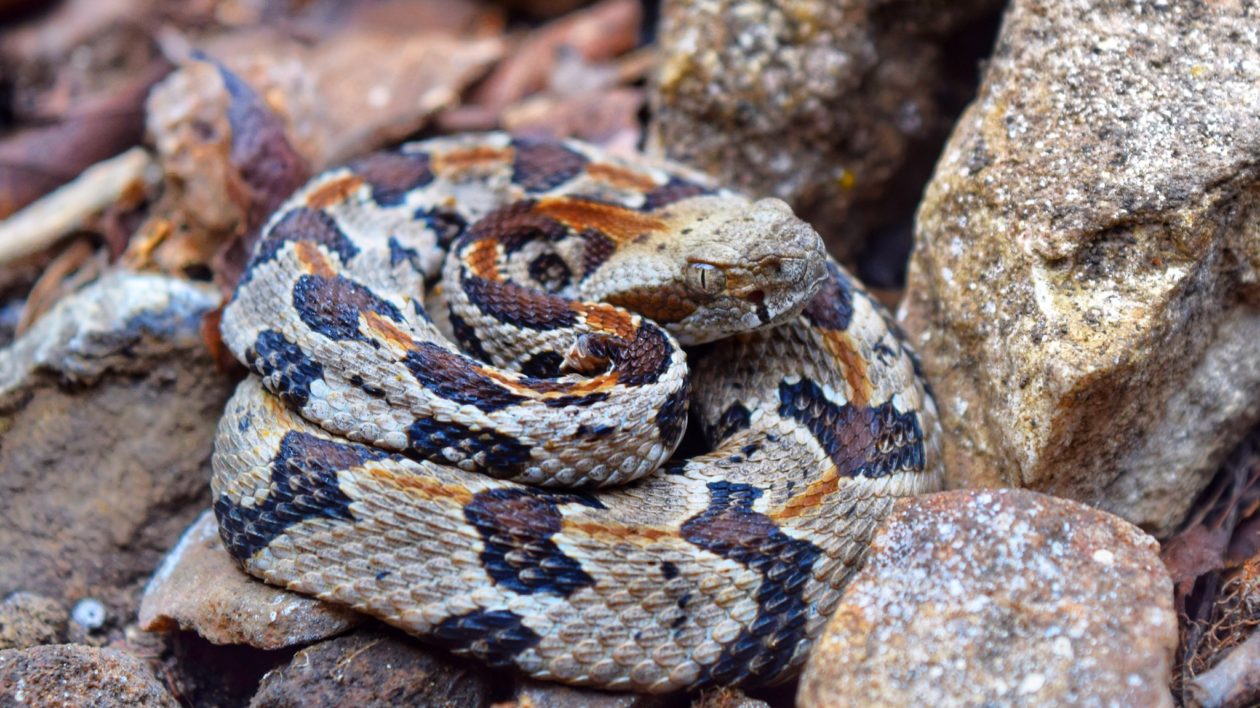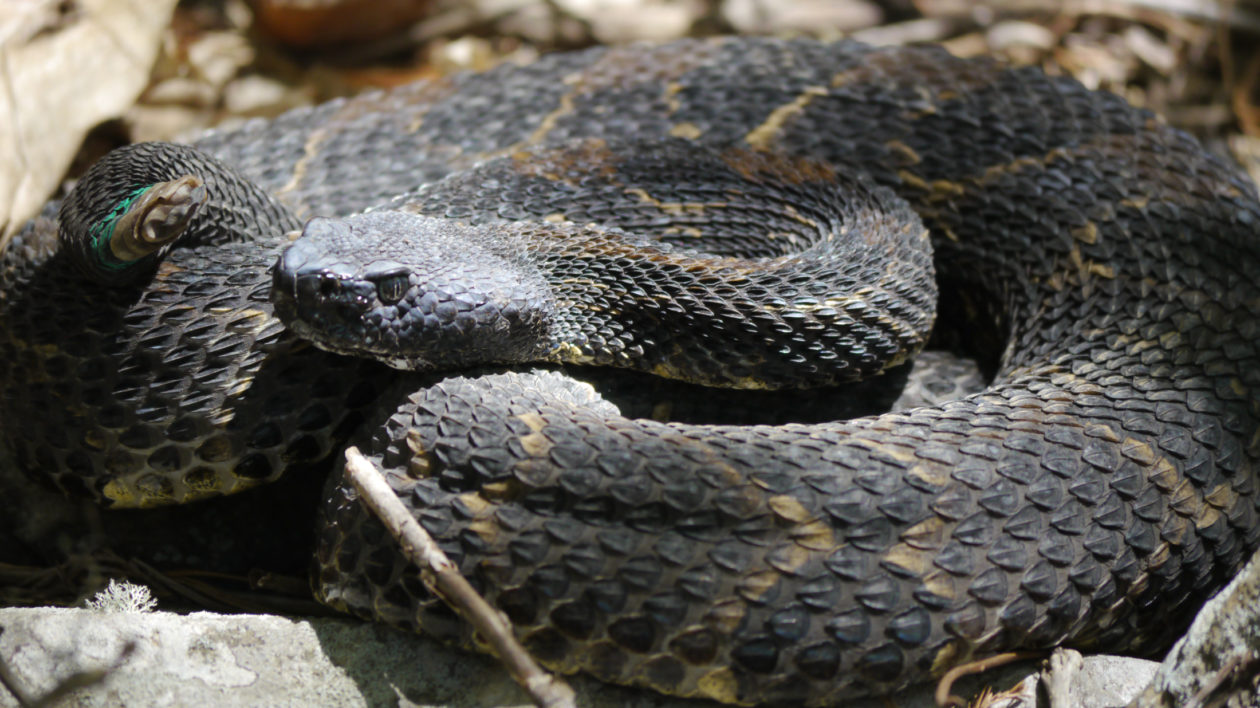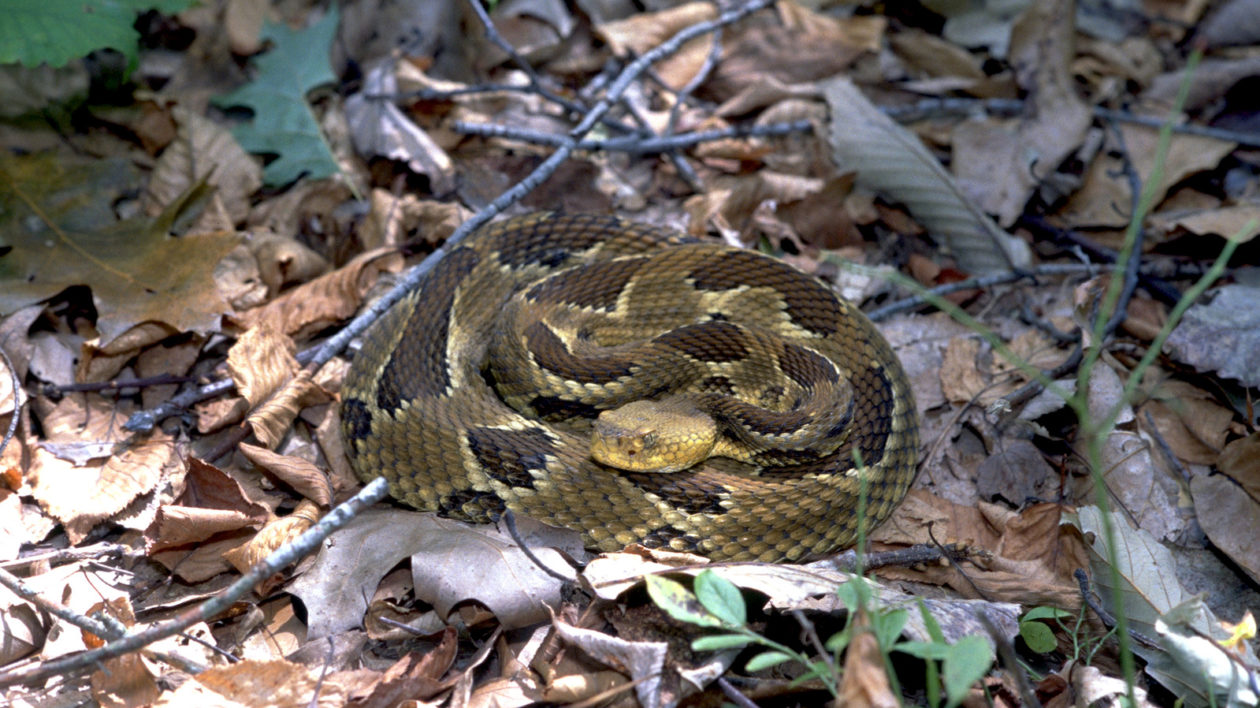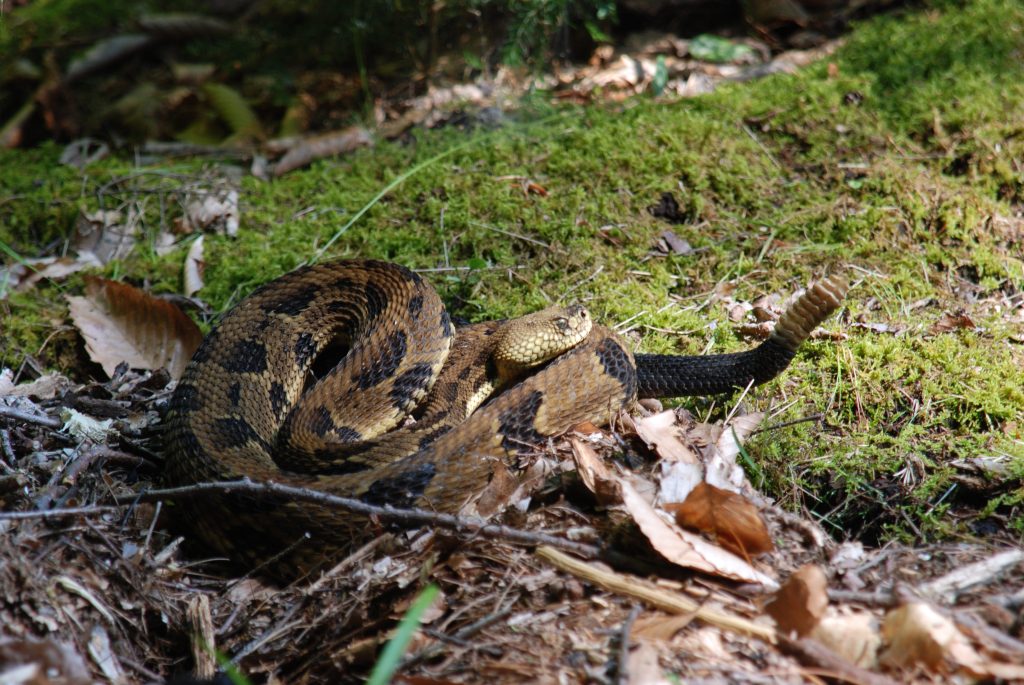I know a few avid anglers who hold their favorite fishing holes in such high regard that in the extremely rare event they invite you to cast there, you better not hiccup a hint of the location. It’s the same attitude a skier has about a secret powder stash.
But a herpetologist who knows where a snake lives? That’s a new level of secrecy. Especially researchers in upstate New York and northern New England about timber rattlesnake dens. That’s fine with me. Like Indiana Jones, I’m always up for adventures in remote places, but snakes give me the creeps. However, sometimes those slithering serpents show up when you least expect.
My friend, Liz, wanted to celebrate her graduation from nursing school with an overnighter in the backcountry. I needed to hike the Tongue Mountain Range, a peninsula that juts into Lake George in the eastern Adirondack Park, for a guidebook I was writing. The area was one of the few places in New York where timber rattlesnakes had escaped a couple hundred years of bounty hunters, fearful farmers and pet-trade poachers. I wasn’t worried. I had hiked Tongue Mountain many times without a single telltale tail shake.
“What’s this?” asked Liz, leaning toward something in the hollow of a rotting log. A timber rattlesnake stared back, tightly coiled, shaking the tip of its tail at her. I grabbed her pack, yanking her backward. An angry snake can strike the distance of at least half its body length.

“It’s a timber rattlesnake!” I shouted, both awed at the rare privilege of actually seeing it and scared to death. Timber rattlers (Crotalus horridus) are the largest venomous snake in New York. They can grow more than six feet long.
It was difficult to tell the size of this one, but it was definitely mature, as big around as my wrist. Despite its bulk, we would have walked by it if it hadn’t rattled at us.
A timber rattlesnake is well-camouflaged. It has two color phases, yellow (which can also appear light brown or gray) with dark bands, and black with less noticeable dark bands. Both phases blend perfectly into the floor of the deciduous oak-hickory forests where they live.

A member of the pit-viper family, a timber rattlesnake has “pits” on either side of its face below its eyes, which are temperature sensitive and help it sense when prey or predators approach. It doesn’t chase its food, usually a rodent like a white-footed mouse, a chipmunk or a squirrel.
Instead, it lies quietly, waiting for the opportunity to strike. Since it takes a lot of energy to produce venom, which it mainly needs to acquire food, the average snake isn’t keen to strike a hiker, but we didn’t want to take any chances and moved quickly out of the area.
When I got out of the woods, I learned a lot more about this stealthy snake. Here are some cool facts about timber rattlesnakes:
- Every time a timber rattlesnake sheds its skin, every one to two years, it adds a new segment to its rattle.
- Timber rattlesnakes are slow reproducers. Males take five years to reach sexual maturity. Females take up to a decade to mature, then they give birth only every three to five years and maybe to only four baby snakes, though the average is nine. Only a third of all females reproduce more than once.
- Timber rattlesnakes don’t lay eggs. The foot-long baby rattlers are born encased within a membrane that they immediately shed. They are born with venom in their hollow fangs and a small “button” rattle.
- Mother rattlesnakes guard their young for a week or two, until they shed their skin for the first time.
- Timber rattlesnakes can live over 30 years.
- Timber rattlesnakes den with other snake species during the winter, typically on south-facing slopes under talus or inside rock fissures.
- After emerging in the spring, timber rattlesnakes migrate up to four miles from their winter den. They typically return to the same den each fall.
- In the northern part of their range, where they are the rarest, these cold-blooded herps are only active five months per year, from May to September.

After my up-close-and-personal encounter with a timber rattlesnake, I’ve gained a new respect for the species. This species historically slithered in forests from Georgia to southern Canada and from northeastern Texas to southwestern Wisconsin. It was a symbol of the American Revolution. The snake on the Gadsen flag of 1778, with its famous slogan, “Dont tread on me”, was a timber rattlesnake.
Interestingly, the IUCN categorizes the timber rattlesnake as a species of least concern, but that’s a slithery slope. They still exist in large numbers in the south but have fallen on hard times in the northernmost parts of their range due to a slow rate of reproduction, loss of habitat, illegal collection and disturbances by an increasing number of recreational users.
They’ve been extinct in Canada since 2001. Timber rattlers are listed as endangered in seven states – New Jersey, Vermont, Massachusetts, Virginia, New Hampshire, Indiana and Ohio – and threatened in New York, Connecticut, Illinois, Minnesota and Texas.
Their northern woes are exacerbated by their group hibernation, which makes them more vulnerable to snake-haters, who can take out an entire population at once, and the black market for snake pets for the same reason.

If roads cross their migratory path, they are vulnerable to getting run over. What’s more, beginning in 2006, they started turning up with snake fungal disease (SFD), which causes lesions on their faces and bodies.
It’s a disease similar to white-nosed syndrome in bats which was discovered that same year and in the same state, New York. SFD causes behavioral changes, like more frequent skin shedding, lack of appetite which can lead to starvation, and disorientation about when to take shelter, which makes them more vulnerable to predators and exposure.
There’s a lot to love about timber rattlers. They are part of the food web, helping to keep populations of small rodents in check. They’re shy and unaggressive, preferring to hide or, if moving, stick stubbornly to their course.
Sure, they’ll coil and rattle if an intruder comes near, but if you move on, they settle down. In fact, their bites are exceedingly rare, and most that do occur are people actively harassing or handling the snakes. If you leave them alone, chances are you’ll never see them – but know you’ve probably walked by them in the eastern forest. Just knowing they’re there is enough, especially if you’re a bit squeamish around snakes.




Timber rattlesnakes shed more than “once a year.” In the southern Adirondacks on NY, studies show they average 1.5 sheds per year. More south, which is the heart of their range, they shed more often.
Timber rattlesnakes are occicially designated as “endangered” in CT as well – 8 states.
I own a 160 acre farm about 35 miles North of Oklahoma City. I have a lot of Timber Rattlesnakes on my land. Last year I captured 6 out of my machinery shop. This year I have removed 2 from the shop. I guess they like the cool concrete floor or maybe it’s the John Deere tractors and equipment. I keep rat and mice poison out in the shop to deter their population. I keep 4 snake tongs in different places in my shop to remove the snakes from my shop and release them about 3/4 mile away in a rough area where there are no houses or livestock. I wear boots and watch where I step and where I put my hands when I’m working at the farm. I have found one coiled up under the hood of my farm truck. You can’t be too careful in rattlesnake country. I think they have a part in our ecology system. I just don’t like them in my shop, barns, yard or near the farm house. I don’t want to get bitten by one.
How many times do they shed a year?
Isn’t it true they have been reintroducing rattlers in Vsrmont? I heRd this locally near Stowe?
They haven’t been “extinct” in Canada. Extinct means gone forever. They were extirpated. Using sloppy language minimizes the severity of the problem.
Go yell at a manager, Karen.
Very good article. I enjoyed finding out about the timber rattlesnake and where it lives because I love animals and it’s a huge shame to see them all dying
CAPS ARE OR PHYSICAL REASONS. NOT YELLING.
I GREW UP AROUND RATTLERS. WE LIVED ON THE SNAKE RIVER IN IDAHO. LIVING ON THE LAND AND IN THE MIDDLE OF NOWHERE WITH WILD MUSTANGS RUNNING FREE. AS WE DID NOT HAVE POWER THERE WAS NO TV OR RADIO TO KEEP ME IN THE HOUSE AND I SPENT EVERY SPARE MOMENT OUTSIDE HIKING THE DESERT, ROCK HUNTING, TALKING TO ANIMALS, AND JUST ENJOYING NATURE. I MADE FRIENDS WITH ANYTHING THAT BREATHED INCLUDING RATTLESNAKES. MY FIRST ENCOUNTER WAS WITH A VERY BIG RATTLER ASLEEP ON THE PATH I WAS TAKING. HE DID NOT WAKE UP FIGHTING. A LOT OF RATTLERS HAVE EVOLVED NOT TO HAVE RATTLERS AS THIS ONE HAD. HE STARED AT ME I STARED BACK FROZEN IN SPOT. SIGNALING TO MY DOG TO BACK OFF I WAS GOING TO DO THE SAME WHEN FOR WHATEVER WAS IN MY YOUNG MIND INSTEAD I BOWED AND SAID I WAS SORRY FOR WAKING HIM UP AND VERY SLOWLY MADE A WIDE PATH AROUND HIM. HE WAS ALREADY BACK TO SLEEP BEFORE I WAS OUT OF SIGHT.
WE HAD TO SEARCH UNDER THE FURNITURE EVERY DAY FOR RATTLERS WHO LIKE TO FIND COOL PLACES IN SUMMER. WE TOOK A RATTLER BACK OUTSIDE A FEW TIMES DURING THE SUMMER. WE EVEN NAMED ONE PRETTY LITTLE FEMALE WHO CAME COMING BACK. EVERYBODY ELSE TOOK OFF AND KEPT GOING. ENDED UP LETTING HER LIVE IN AN ABANDONED SHED IN BACK OF THE HOUSE.
IN OREGON I HAVE STEPPED OVER LOGS TO DISCOVER A RATTLER UNDERNEATH WHEN I GOT TO THE OTHER SIDE SO BE CAREFUL.